Wind gusts can transform an ordinary BBQ session into a hazardous scenario, posing significant risks to your culinary endeavors and safety. These sudden, strong winds have the potential to topple your grill, leading to possible damage to the grill itself and surrounding property or even causing fire hazards if hot coals or gas flames are involved. To mitigate these risks, it’s essential to learn how to secure grill from wind effectively.
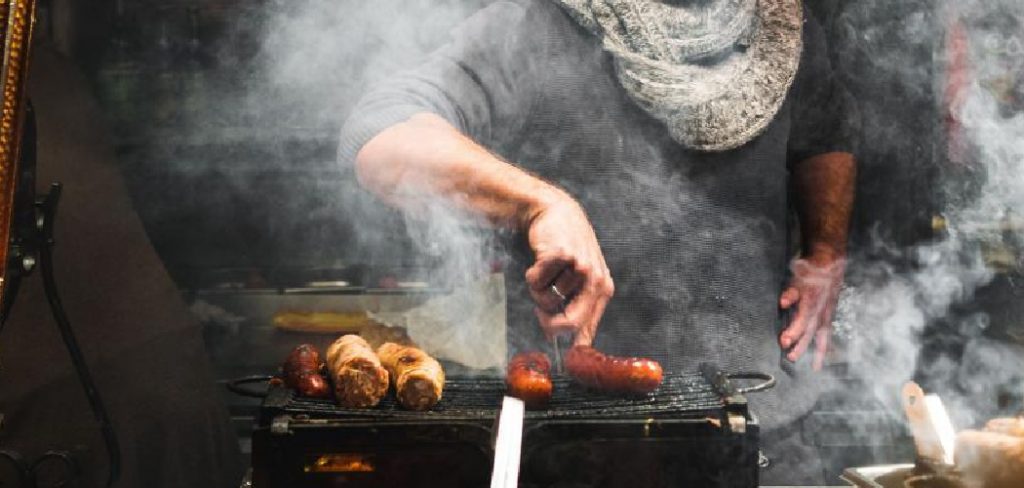
This guide will explore various strategies, from weight-based methods and anchoring techniques to grill cover strategies and building wind shields, offering a comprehensive overview of how to protect your grill and ensure a safe, enjoyable grilling experience despite the challenges posed by windy conditions.
Understanding Wind Risks
Wind Gusts and Their Impact
Wind gusts, with their sudden and unpredictable nature, can exert significant force on outdoor objects, including grills. These gusts are particularly hazardous because they can occur without warning, turning a calm grilling session into a potential safety hazard.
The impact of wind gusts largely depends on the grill’s weight and design; lighter and more aerodynamically designed grills are more susceptible to being tipped or moved by strong winds. Understanding how wind gusts work and the factors that make your grill vulnerable is key to developing effective strategies to secure it.
Local Wind Patterns
Familiarizing yourself with the local wind patterns in your area is an essential step toward securing your grill against sudden gusts. Many areas have prevailing winds that come from a particular direction, which can have a significant impact on how you set up your outdoor cooking space.
By researching and understanding these local wind patterns, you can strategically place your grill in a more sheltered location, if possible, to minimize the risk of wind-related incidents. Additionally, positioning your grill near natural windbreakers, such as walls or hedges, can offer added protection.
Weight-Based Securing Methods
Utilizing Concrete Pavers or Bricks
One of the simplest yet effective methods to secure your grill against the force of wind is by using heavy objects such as concrete pavers or bricks. These items, commonly available and inexpensive, can be strategically placed around the base of the grill to significantly increase its stability.
The key is to distribute these weights evenly around the perimeter, ensuring that the grill is anchored firmly in place. This approach not only prevents the grill from tipping over in strong gusts but also minimizes the likelihood of it being moved across the surface.
Placing pavers or bricks directly in front or behind the wheels for grills with wheels can effectively immobilize the grill. It’s crucial, however, to consider this method’s overall aesthetic and practicality, making sure that the bricks or pavers do not obstruct access to the grill or pose a tripping hazard.
Filling the Grill Base with Sand
Another method worth considering, especially for grills with a hollow base, is filling this cavity with sand. This technique adds a significant amount of weight to the grill without altering its appearance.
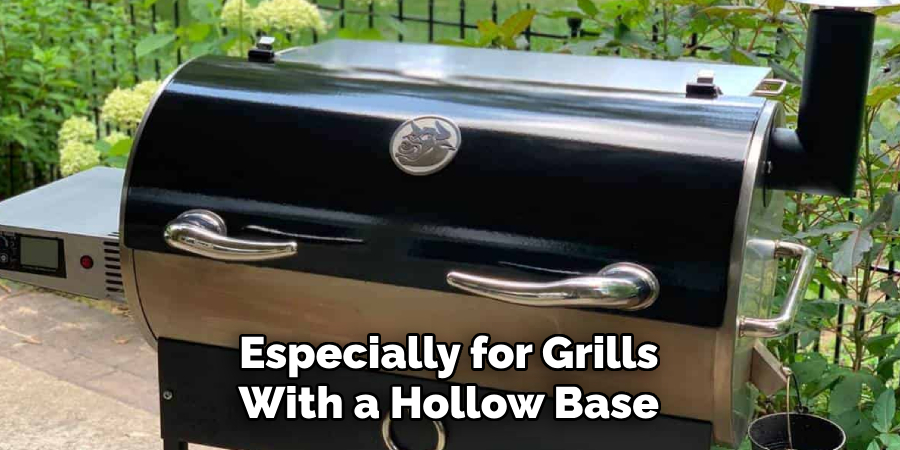
Proper drainage within the base is essential to prevent water accumulation and potential rust issues. A layer of sand can be an effective and unobtrusive way to enhance the stability of your grill, especially in regions susceptible to frequent and unpredictable wind gusts.
Using Grill Weights
For those seeking a more refined solution, commercially available grill weights offer a convenient and aesthetically pleasing option. These weights are specifically designed to add stability to grills, with various options available to suit different grill types and sizes.
From decorative weights that hang from the sides to base weights that sit underneath, there’s a solution for every need. When selecting grill weights, consider the specific design and material of your grill to ensure compatibility and effectiveness in wind resistance.
How to Secure Grill from Wind: Anchoring Techniques
1. Securing a Permanent Structure
An effective strategy for ensuring your grill withstands strong gusts of wind involves securing it to a permanent structure such as a deck or patio. This method requires using anchoring kits designed for outdoor appliances, ensuring a robust connection that dramatically reduces the risk of your grill being tipped over by the wind.
Before implementing this technique, it’s crucial to assess the structural integrity of the anchoring point to guarantee it can support the grill’s weight and the added force of wind gusts. Additionally, adherence to local building codes and regulations is paramount, as some areas may have specific rules regarding permanent attachments to existing structures.
Safety precautions, such as ensuring the grill is still a safe distance from combustible materials and verifying that the anchoring hardware is rated for the grill’s weight and outdoor use, are essential considerations to maintain both safety and compliance.
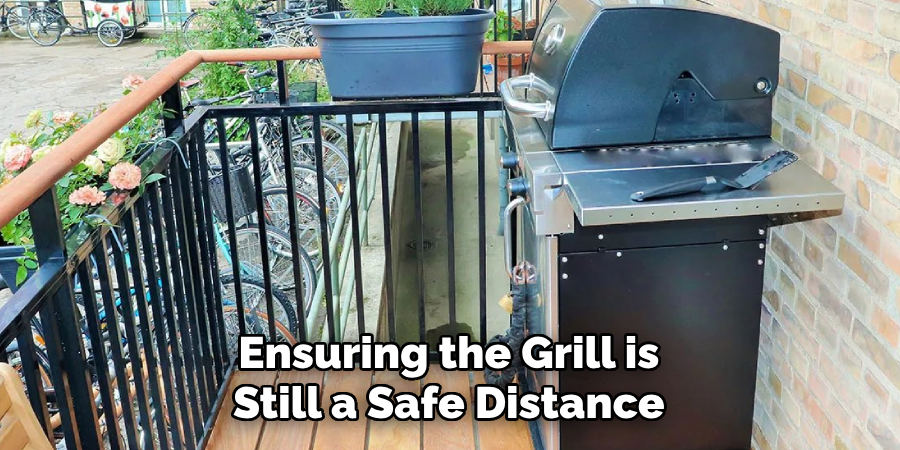
2. Utilizing Tie-Down Straps
Heavy-duty tie-down straps present another viable option for securing your grill against the wind. These straps can be fastened around the grill and anchored to a stationary object, like a post or the side of your house, offering a flexible yet sturdy solution.
When utilizing tie-down straps, placing them at strategic points on the grill, usually around the base and under the grill body, ensures maximum stability. It’s important to select weather-resistant straps with adequate load ratings and to tighten them properly to avoid any slippage that could undermine the grill’s security.
3. Ground Anchors
For grills equipped with designated anchor points, ground anchors — either screw-in types for soft ground or stake-down models for harder surfaces — provide a reliable anchoring solution. The choice of anchor should be dictated by the soil conditions in your grilling area; softer soils are more conducive to screw-in anchors, while stake-down anchors are better suited for more compact ground.
Installing these anchors requires digging to the appropriate depth and securing the grill tethered to these points. This method not only stabilizes the grill against winds but also deters theft, adding an extra layer of security to your outdoor cooking setup.
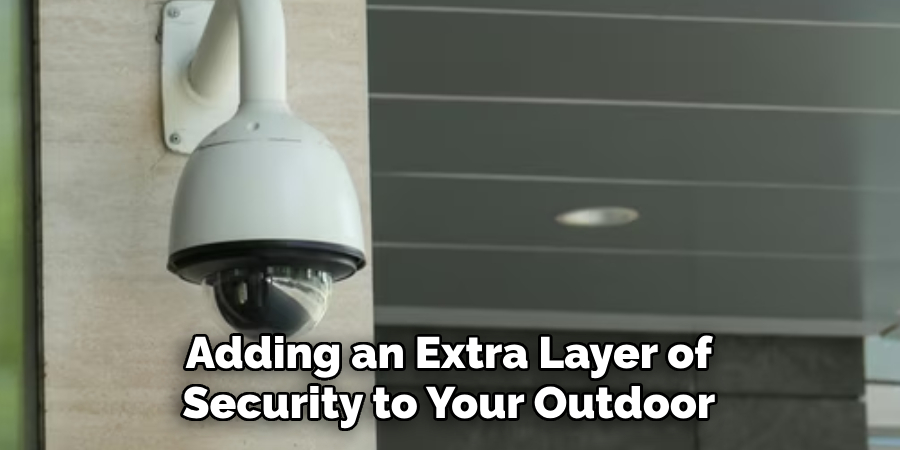
How to Secure Grill from Wind: Grill Cover Strategies
1. Choosing the Right Grill Cover
Selecting a high-quality grill cover that fits snugly is crucial for effective wind protection. A well-fitted cover not only shields your grill from dust, debris, and moisture but also plays a significant role in wind resistance.
Look for covers equipped with additional features such as wind straps and cinch cords, which enable tighter adjustment to withstand strong gusts. These added layers of security ensure the cover stays in place, protecting your grill from the elements and extending its lifespan by preventing rust and corrosion.
2. Securing the Grill Cover in Windy Conditions
To ensure your grill cover provides maximum protection in windy conditions, utilizing the straps and fasteners that typically come with the cover is essential. These features are designed to secure the cover tightly around the grill, preventing it from being blown away or leaving parts of the grill exposed to the elements.
For additional security, bungee cords can be used to further tighten the cover across the grill, especially in areas prone to extreme weather conditions. Another effective strategy involves placing heavy objects, such as bricks or weights, on the corners of the cover. This method adds weight, reducing the cover’s tendency to flap or lift in strong winds.
When employing these methods, ensure that sharp edges do not come into contact with the cover to avoid tears or damage. By making good use of the cover’s built-in features and supplementing with these additional securing techniques, you can significantly enhance your grill cover’s effectiveness in protecting your grill from wind damage.

Additional Tips and Considerations
Beyond physical preparations and securing mechanisms, adjusting your cooking methods can markedly improve the grilling experience in windy conditions. Consider lowering the heat to compensate for the increased air circulation, which can cause rapid temperature changes.
Additionally, implementing a portable windshield can provide an effective barrier against gusts, enabling more consistent heating and reducing the likelihood of flare-ups. These strategies, when combined with the structural precautions outlined previously, ensure not just the security of your grill but also the quality and safety of the food you prepare, regardless of weather conditions.
Selecting the Right Grill for Windy Conditions
A. Weight Considerations
When selecting a grill for areas prone to strong winds, the weight and base width of the grill are critical factors. A heavier grill, especially those with a broader base, inherently offers better stability and wind resistance. T
his is because the added weight and design ensure the grill remains grounded, even under the onslaught of high wind speeds. Opting for a heavier model can significantly minimize the risk of the grill tipping over or moving out of place, thus enhancing safety and ensuring a more reliable grilling experience.
B. Portable vs. Stationary Grills
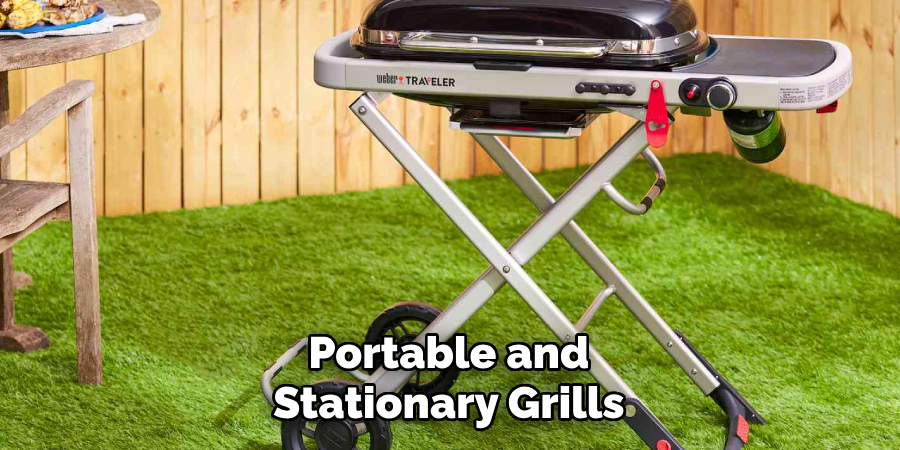
The choice between portable and stationary grills is crucial in terms of wind security. Portable grills offer flexibility and convenience, allowing for relocation to more protected areas during windy conditions. However, their lighter weight and smaller size can compromise stability in high winds.
On the other hand, stationary grills, often heavier and designed to be permanent fixtures, provide enhanced wind resistance and stability. The downside is their lack of mobility, which requires careful initial placement. Balancing the need for mobility against wind security is a key consideration when choosing the right grill.
C. Wind Shield Compatibility
Grills designed for use with windshields have a clear advantage in gusty conditions. Windshields not only protect the flame from being extinguished but also ensure more even heat distribution, securing a more consistent cooking experience. Consider grills that come with integrated windshields or have the option to add aftermarket shields.
This compatibility with windshields can dramatically improve the grilling process in windy environments, preserving the integrity of the cooking flame and preventing heat loss. Windshield compatibility ensures optimal performance and security against wind-related disruptions when combined with weight and design considerations.
Building a Wind Shield
A. Materials and Tools
Constructing a sturdy windshield requires basic materials such as metal sheets, cinder blocks, or treated wood planks for natural resistance to the elements. Opt for aluminum or stainless steel sheets for a metal shield for their durability and rust resistance.
Tools may include a metal cutter for shaping the sheets, a drill for creating attachment points, and safety equipment such as gloves and eye protection. Cinder blocks or heavy-duty brackets will serve as supports. If opting for a wood construction, a saw for cutting planks and waterproofing sealant are additional necessities.
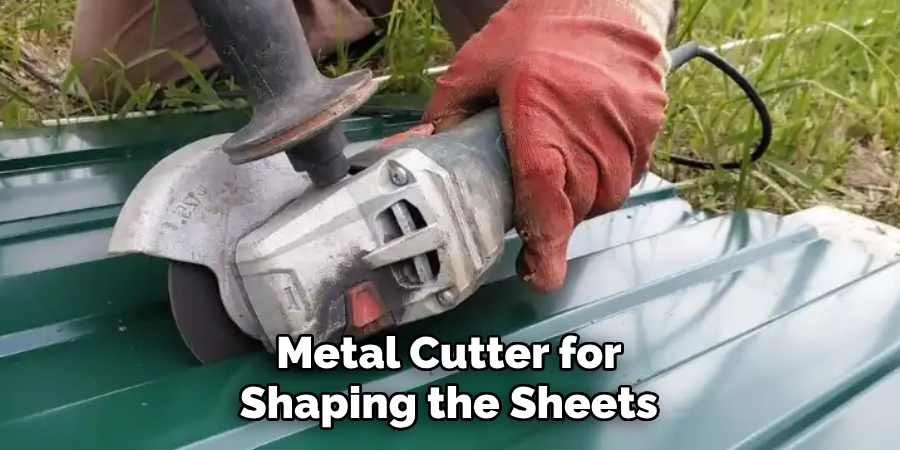
B. Simple Wind Shield Designs
Freestanding Metal Sheet Barrier
A straightforward approach to creating a wind barrier involves using a large metal sheet. This sheet can be held upright by positioning it between sturdy cinder blocks placed on either side or by driving metal stakes into the ground to secure its edges.
Ensure the metal sheet is tall and wide enough to shield the grilling area effectively. This method is easily customizable to fit various grill sizes and is particularly useful for temporary setups or when minimal installation effort is desired.
L-Shaped Wind Shield with Legs
An L-shaped metal wind shield offers heightened stability for a more permanent solution. This design uses a metal sheet bent at a right angle, with extended “legs” that can be bolted or anchored into the ground or patio surface.
The L-shape provides a broader area of protection from the wind. Its anchored legs prevent tipping in strong gusts. This option is well-suited for stationary grilling setups where ongoing wind protection is necessary.
C. Customizable Wind Shield Options
For grill masters seeking a tailor-made solution, building a custom wind shield from wood or combined materials offers versatility and aesthetic appeal. Measure your grill area to determine the required shield size and choose materials that blend with your outdoor space.
Wood planks offer natural beauty and can be treated with weatherproof sealants for durability. Metal brackets or frames can add structural integrity. This approach allows for a personalized touch, matching the shield to your grill’s dimensions and outdoor decor while effectively blocking the wind.
Grill Maintenance and Wind Prevention
A. Regular Cleaning and Maintenance
Regular cleaning and maintenance of your grill are vital, not only for hygiene and functionality but also to minimize wind-related issues. Over time, grills can accumulate grease, debris, and loose parts that may catch the wind, leading to potential safety hazards.
Ensuring that your grill is clean and all parts are tightly secured reduces the risk of components flapping or detaching in strong winds. Additionally, a well-maintained grill will have a longer lifespan and better performance, providing a more enjoyable cooking experience regardless of the weather conditions.

B. Storing the Grill When Not in Use
When your grill is not in use, especially during periods of high wind or inclement weather, storing it in a sheltered location can protect it from damage and reduce the risk of it becoming a wind hazard.
If moving the grill to a sheltered area is not feasible, investing in a heavy-duty grill cover that can be securely fastened will provide protection from the elements. This not only keeps your grill in optimal condition but also ensures that it remains stable and secure, preventing it from being blown over or damaged by strong winds.
Frequently Asked Questions
Q1: Can Windshields Be Used with All Types of Grills?
A1: Most grills, whether charcoal, propane, or natural gas, can be fitted with a windshield. However, the compatibility and type of windshield may vary depending on the grill’s design and manufacturer.
It’s crucial to check with the manufacturer or a professional before installing a windshield to ensure it won’t interfere with the grill’s operation or safety features.
Q2: How Do I Determine the Right Size for A Freestanding Wind Shield?
A2: The size of your windshield should be based on the dimensions of your grilling area and the average wind direction and speed in your location. Ideally, the shield should be tall enough to block wind effectively and wide enough to cover the cooking area. A rule of thumb is to make the shield a few inches taller than your grill and at least as wide as the grill’s length.
Q3: Are There Any Safety Concerns I Should Be Aware of When Using a Wind Shield?
A3: Yes, proper ventilation is crucial when grilling with a windshield to prevent the build-up of harmful gases, especially when using charcoal or gas grills. Ensure that the windshield does not completely enclose the grilling area and that there’s ample space for air circulation. Additionally, the shield should be made of non-combustible materials and securely anchored to prevent it from toppling over.
Q4: Can I DIY a Wind Shield, or Should I Buy a Pre-Made One?
A4: Both options are viable. DIY windshields offer customization and can be a cost-effective solution. However, it requires some handyman skills and the right materials. Pre-made windshields, on the other hand, are designed for quick installation and are often tested for safety and efficiency. Your choice should depend on your level of expertise, budget, and specific needs.
Q5: How Often Should I Perform Maintenance Checks on My Grill and Wind Shield?
A5: It’s recommended to perform a thorough inspection of your grill and wind shield at least once at the beginning of the grilling season and then regularly throughout its usage, especially after extreme weather conditions. This includes checking for any loose parts, signs of wear and tear, and ensuring that the grill and shield are clean and free from grease build-up.
Conclusion
In summary, learning how to secure grill from wind involves a combination of choosing the right grill type, understanding the significance of windshield compatibility, and constructing effective wind barriers as needed. Whether opting for a portable grill for its flexibility or a stationary grill for its inherent wind stability, each choice requires careful consideration of your particular environment and grilling habits.
Windshields and custom-built barriers, ranging from simple metal sheets to aesthetically pleasing wooden constructs, play a crucial role in protecting the flame and ensuring even heat distribution. Regular maintenance and thoughtful storage further safeguard your grill from the whims of the weather. Ultimately, the goal is to select a method that aligns with your grill type, specific needs, and budget constraints.
By doing so, you can achieve worry-free grilling, delighting in the pleasure of outdoor cooking without the interruption of gusty conditions. This guide underscores the joy of uninterrupted culinary exploration outdoors, laying out the tools and strategies for a seamless experience, regardless of the wind’s whims.
About
Safety Fic is a distinguished figure in the world of Diy design, with a decade of expertise creating innovative and sustainable Diy solutions. His professional focus lies in merging traditional craftsmanship with modern manufacturing techniques, fostering designs that are both practical and environmentally conscious. As the author of diy, Safety Fic delves into the art and science of Safety Fic-making, inspiring artisans and industry professionals alike.
Education RMIT University
(Melbourne, Australia) Associate Degree in Design (Safety Fic) Focus on sustainable design, industry-driven projects, and practical craftsmanship. Gained hands-on experience with traditional and digital manufacturing tools, such as CAD and CNC software.
Nottingham Trent University
(United Kingdom) Bachelor’s in diyfastly.com and Product Design (Honors) Specialized in product design with a focus on blending creativity with production techniques. Participated in industry projects, working with companies like John Lewis and Vitsoe to gain real-world insights.
Publications and Impact
In diy, Safety Fic his insights on indoor design processes, materials, and strategies for efficient production. His writing bridges the gap between artisan knowledge and modern industry needs, making it a must-read for both budding designers and seasoned professionals.
